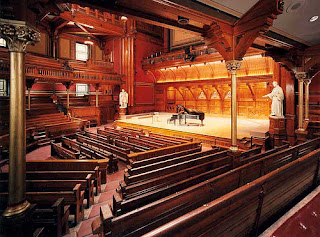
Guest Writer: Georgia Halliday
Normally, when we perform, the basic idea is pretty simple: We put on our uniforms, get up on stage, do what we’ve been practicing in rehearsal, try to remember that crescendo in measure 35, and hopefully at the end everybody claps.
Throw a hundred other musicians into the process, and things get more complicated.
This is the challenge we were faced with when we performed Mahler’s Third Symphony with the Boston Conservatory Orchestra and Women’s Chorus. Let me first say that if you haven’t listened obsessively to Mahler’s symphonies for at least several weeks, then you have missed out enormously: they are beautiful. The Third is less frequently performed than the others because it requires a very large orchestra and a long attention span (the full symphony lasts over an hour and a half), so this was a rare opportunity for us.
One of the biggest challenges we had to overcome was that of volume. The BCC was singing the part of the Knabenchor, or Bell Choir, in the fifth movement. Being a bell choir meant we spent a considerable amount of time singing “Bimm, bamm, bimm, bamm,” which is mostly humming. Try humming over an orchestra. It’s pretty hard.
With a little maneuvering, we managed to solve that problem by assigning some members of both the BCC and the Women’s Chorus to sing more vowel and less hum (“Shh, don’t tell,” whispered the conductor of the Women’s Chorus).
Working with the orchestra was also unusual for us because we had a different conductor, the Boston Conservatory conductor Bruce Hangen. Not only did he have a whole orchestra to concentrate us, he was far below on the stage while we sang from the mezzanine, which forced us to be more independent and concentrate on our own entrances and cutoffs.
While rehearsing the piece on our own, we spent a while going over how to find each note for each entrance by looking at the parts of the other choir, the soloist, or the orchestra. When we arrived at the first rehearsal with orchestra, everyone was impressed when we told them, “Sure, we can find our note from that last A in the fourth movement. We just go down a major third and then jump three octaves.”
Sanders Theatre at Harvard is a beautiful building to perform in: the tall hall makes for great acoustics and my friend Cyrus spent several minutes waxing poetic about the architecture. It is always a wonderful experience to be a part of an ensemble that big, feeling the power of the music filling the room. You could close your eyes and imagine that there really were angels singing.